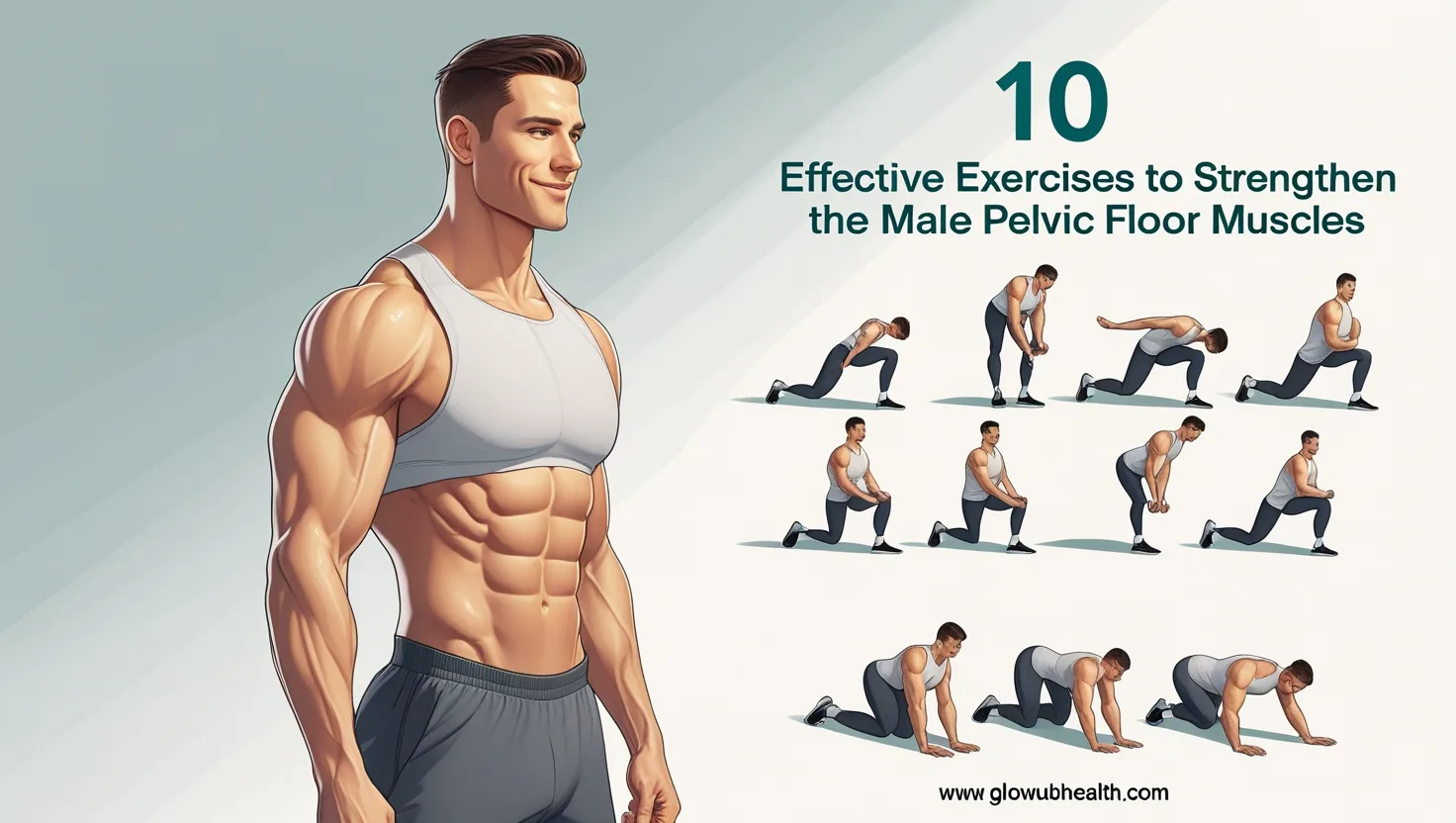10 Effective Exercises to Strengthen the Male Pelvic Floor Muscles
Pelvic health is a crucial aspect of men’s well-being, but it’s often one that doesn’t get the attention it deserves. Strengthening the pelvic floor muscles can have a profound impact on bladder control, sexual performance, and overall core stability.
In this article, we’ll explore 10 effective exercises specifically designed to strengthen the male pelvic floor. These exercises are backed by science and provide actionable steps that can be easily incorporated into your routine. Let’s dive into why pelvic floor health matters and how these exercises can make a real difference in your life.
This article is for informational purposes only and does not constitute medical advice, diagnosis, or treatment. Always consult with a healthcare provider before starting any pelvic floor exercises, especially if you have existing health conditions or concerns related to your pelvic health.
What Are Male Pelvic Floor Muscles?
The pelvic floor muscles in men form a hammock-like structure that supports the bladder, bowel, and, in part, the prostate. These muscles play a vital role in urinary and bowel control and are involved in sexual function. Weakness in these muscles can lead to issues such as incontinence or erectile dysfunction. By incorporating pelvic exercises for men, you can maintain or improve your pelvic health.

Benefits of Strengthening the Male Pelvic Floor
Strengthening the pelvic floor has numerous benefits, including:
- Improved Bladder Control: Helps manage urinary incontinence.
- Enhanced Sexual Performance: Improves erectile function and ejaculation control.
- Core Stability: Supports posture and reduces lower back pain.
- Prostate Health: May reduce symptoms of prostate-related conditions.
- Injury Prevention: A strong pelvic floor protects against strains during physical activities.
10 Effective Exercises to Strengthen the Male Pelvic Floor Muscles
1) Kegel Exercises for Men
Primary Focus: Isolating and strengthening the pelvic floor.
Kegel exercises are the cornerstone of pelvic floor health. To perform a Kegel exercise:
- Identify the pelvic floor muscles by stopping urination midstream (only for identification, not regular practice).
- Contract the muscles for 3-5 seconds.
- Relax for the same duration.
- Repeat 10-15 times, 3 sets daily.
Pro Tip: Perform Kegels while seated, standing, or lying down to add variety.

2) Bridge Pose
Primary Focus: Pelvic activation and glute strengthening.
Steps:
- Lie on your back with knees bent and feet flat on the floor.
- Engage your pelvic floor and lift your hips towards the ceiling.
- Hold for 5 seconds before lowering.
- Repeat 10-15 times.
This exercise not only strengthens the pelvic floor but also improves hip and core stability.
Read More: How to Start a Workout Routine : 10 Proven Ways to Build Consistency

3) Squats
Primary Focus: Full-body strength with pelvic engagement.
Steps:
- Stand with feet shoulder-width apart.
- Lower your body into a squat while engaging the pelvic floor.
- Rise back to standing while maintaining pelvic contraction.
- Perform 2-3 sets of 10-12 reps.
Tip: Start with bodyweight squats and progress to weighted squats for added intensity.

4) Bird Dog
Primary Focus: Core stability and pelvic alignment.
Steps:
- Begin on all fours, hands under shoulders, knees under hips.
- Extend your right arm and left leg while engaging the pelvic floor.
- Hold for 5 seconds and return to the starting position.
- Alternate sides and repeat 10-15 times per side.
This exercise promotes balance and coordination while strengthening the pelvic floor.

5) Plank with Pelvic Engagement
Primary Focus: Core and pelvic floor activation.
Steps:
- Assume a forearm plank position.
- Engage your core and contract the pelvic floor.
- Hold for 20-60 seconds.
- Gradually increase the duration as strength improves.

6) Seated Squeezes
Primary Focus: Isolated pelvic contractions.
Steps:
- Sit on a chair with feet flat on the ground.
- Contract your pelvic floor as if stopping urination.
- Hold for 5 seconds, then release.
- Repeat 10-15 times, 3 sets daily.
Adaptation: Perform seated squeezes during work breaks or while commuting.

7) Reverse Kegels
Primary Focus: Relaxation and control of the pelvic floor.
Steps:
- Focus on the sensation of pushing out, as if initiating urination.
- Hold the push for 3-5 seconds.
- Relax and repeat 10 times.
This exercise complements traditional Kegels by promoting balance between contraction and relaxation.

8) Side-Lying Leg Lifts
Primary Focus: Hip and pelvic stability.
Steps:
- Lie on one side with legs straight.
- Engage your pelvic floor and lift the top leg to about 45 degrees.
- Lower slowly and repeat 10-12 times per leg.
- Perform 2-3 sets per side.
This exercise strengthens the hips and provides support to the pelvic floor.

9) Dead Bug
Primary Focus: Core and pelvic floor engagement.
Steps:
- Lie on your back with arms and legs raised.
- Lower your right arm and left leg while engaging the pelvic floor.
- Return to the starting position and alternate sides.
- Repeat 10-15 times per side.

10) Deep Breathing with Pelvic Contractions
Primary Focus: Pelvic floor activation through diaphragmatic breathing.
Steps:
- Sit or lie comfortably.
- Inhale deeply, allowing your belly to rise.
- Exhale while contracting the pelvic floor.
- Repeat for 5-10 minutes daily.
Mind-Body Connection: Deep breathing helps relax the mind while engaging the pelvic muscles.

Common Mistakes to Avoid
- Overusing Abdominal Muscles: Focus on the pelvic floor, not just the abs.
- Holding Your Breath: Always breathe naturally during exercises.
- Inconsistent Practice: Regularity is key to seeing results.
Practical Tips for Success
- Set a Routine: Integrate these exercises into your daily life, such as during TV time or before bed.
- Track Progress: Maintain a journal to monitor improvements.
- Combine with Lifestyle Changes: Healthy eating and stress management enhance results.
- Gradual Progression: Start with easier exercises and increase difficulty as your strength improves.
Real-Life Success Story
John, a 45-year-old software engineer, experienced frequent urinary leakage. After incorporating Kegel exercises for men and other pelvic-focused routines, he saw significant improvement within three months. Today, John enjoys a more active and confident lifestyle.
Similarly, Mark, an amateur cyclist, found that focusing on pelvic exercises reduced his lower back pain and improved his cycling performance. His story highlights how pelvic health benefits various aspects of life.
Conclusion
Strengthening the pelvic male muscles through these 10 exercises can significantly improve your health and well-being. Whether you’re aiming to enhance bladder control, boost sexual performance, or achieve better core stability, consistency is the key. Start with these exercises today and experience the transformative benefits they bring.
FAQ
1. What are pelvic floor muscles in men?
Pelvic floor muscles in men are a group of muscles that form a supportive hammock across the base of the pelvis. They control urinary and bowel functions, play a role in sexual performance, and contribute to core stability.
2. How do I know if I have weak pelvic floor muscles?
Signs of weak pelvic floor muscles may include:
-Urinary incontinence or dribbling.
-Difficulty controlling bowel movements.
-Erectile dysfunction or reduced sexual performance.
-A feeling of heaviness or discomfort in the pelvic region.
3. How long does it take to see results from pelvic exercises?
With consistent practice, most men begin noticing improvements within 4-8 weeks. Significant benefits, such as better bladder control or enhanced sexual function, may take up to three months.
4. Can Kegel exercises help with erectile dysfunction?
Yes, Kegel exercises for men strengthen the pelvic floor muscles, which can improve blood flow and control, potentially reducing symptoms of erectile dysfunction.
5. How often should I perform pelvic floor exercises?
For optimal results, practice pelvic floor exercises like Kegels 2-3 times daily, aiming for 10-15 repetitions per session.
6. Are pelvic floor exercises safe for everyone?
Pelvic floor exercises are generally safe. However, consult a healthcare provider if you experience pain during exercises or have pre-existing medical conditions like severe pelvic pain.
7. What is the difference between Kegels and reverse Kegels?
Kegels involve contracting the pelvic floor muscles to strengthen them.
Reverse Kegels involve gently relaxing and lengthening these muscles to improve balance and flexibility.
8. Can pelvic floor exercises help with prostate health?
Yes, strengthening pelvic floor muscles can alleviate symptoms related to prostate issues, such as urinary leakage or frequent urination, especially after prostate surgery.
9. Can I do pelvic exercises during other activities?
Absolutely! You can integrate exercises like Kegels into daily routines, such as while driving, sitting at your desk, or watching TV.
10. Do I need special equipment for pelvic floor exercises?
No special equipment is needed. Most exercises, including Kegels and planks, rely on body weight. However, resistance bands or stability balls can be added to enhance certain exercises.





